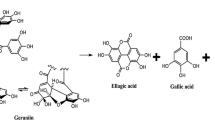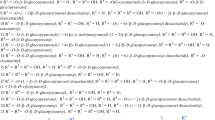Abstract
Kinsenoside is a main active component isolated from plants of the genus Anoectochilus, and exhibits many biological activities and pharmacological effects, including hepatoprotective, anti-hyperglycemic, anti-hyperliposis, anti-inflammatory, vascular protective and anti-osteoporosis effects and so on, which is contributing to its promising potency in disease treatments. This review aims to recapitulate the pharmacological functions of kinsenoside, as well as its source, extraction, identification, quantitative analysis, pharmacokinetics, synthesis and patent information. The data reported in this work can confirm the therapeutic potential of kinsenoside and provide useful information for further new drug development.
Similar content being viewed by others
References
Shao Q, Wang H, Guo H, et al. Effects of Shade Treatments on Photosynthetic Characteristics, Chloroplast Ultrastructure, and Physiology of Anoectochilus roxburghii. PLoS One, 2014,9(2): e85 996
Budluang P, Pitchakarn P, Ting P, et al. Anti-inflammatory and anti-insulin resistance activities of aqueous extract from Anoectochilus burmannicus. Food Sci Nutr, 2017, 5(3): 486–496
Du XM, Toyokichi Y, Yukihiro S. Butanoic acid glucoside composition of whole body and in vitro plantlets of Anoectochilus formosanus. Phytochemistry, 1998, 49(7): 1925–1928
Ito A, Kasai R, Yamasaki K, et al. Aliphatic and aromatic glucosides from Anoectochilus koshunensis. Phytochemistry, 1993, 33(5): 1133–1137
Wang J, Wang H, Zhang A, et al. Recent advances in kinsenoside. Chin Hosp Pharm, 2015, 35(19): 1795–1798
Jiangsu New Medical College. Dictionary of the Traditional Chinese Medicines, Shanghai: Shanghai Scientific Technologic Publishing House, 1986:2283–2286.
Shih CC, Wu YW, Lin WC. Aqueous extract of Anoectochilus formosanus attenuate hepatic fibrosis induced by carbon tetrachloride in rats. Phytomedicine, 2005, 12(6-7): 453–460
Du XM, Sun NY, Hayashi J. Hepatoprotective and antihyperliposis activities of in vitro cammed Anoectochilus formosanus. Phytother Res, 2003,17(1): 30–33
Chen Z, Huang ZQ. Studies on the hypoglycemic effect of the aqueous extractive of Anoectochilus roxburghii. Pharmacol Clin Chin Mater Med, 2000, 16:23–24
Tang J, Deng YR, Zhuo YR, et al. Advances in pharmacological activity of Anoectochilus roxburghii. Strait Pharm J, 2008, 20:77–79
Tseng CC, Shang HF, Wang LF, et al. Antitumor and immunostimulating effects of Anoectochilus formosanus Hayata. Phytomedicine Int J Phytother Phytopharm, 2006, 13:366–370
Liu Q, Ai MQ, Li TY, et al. Protection of kinsenoside against AGEs-induced endothelial dysfunction in human umbilical vein endothelial cells. Life Sei, 2016, 162:102–107
Hsiao HB, Wu JB, Lin H, et al. Kinsenoside isolated from Anoectochilus Formosanus suppresses LPS-stimulated inflammatory reactions in macrophages and endotoxin shock in mice. Shock, 2011, 35(2): 184–190
Cheng KT, Wang YS, Chou HC, et al. Kinsenoside-mediated lipolysis through an AMPK-dependent pathway in C3H10T1/2 adipocytes Roles of AMPK and PPARa in the lipolytic effect of kinsenoside. Phytomedicine, 2015, 22:641–647
Mei Y, Lu H, He L, et al. Kinsenoside and polysaccharide production by rhizome culture of Anoectochilus roxburghii in continuous immersion bioreactor systems. Plant Cell Tiss Organ Cult, 2017, 131:527–535
Zhang Y, Cai J, Ruan H, et al. Antihyperglycemic activity of kinsenoside, a high yielding constituent from Anoectochilus roxburghii in streptozotocin diabetic rats. J Ethnopharm, 2007, 114:141–145
Du X, Sun N, Tamura T, et al. Higher yielding isolation of kinsenoside in Anoectochilus and its antihyperliposis effect. Biol Pharm Bull, 2001,24(1): 65–69
Du XM, Irino N, Furusho N, et al. Pharmacologically active compounds in the Anoectochilus and Goodyera species. J Nat Med, 2008, 62(2): 132–148
Wu JB, Lin WL, Hsieh C, et al. The hepatoprotective activity of kinsenoside from Anoectochilus formosanus. Phytother Res, 2007, 21(1): 58–61
Hsieh WT, Tsai CT, Wu JB, et al. Kinsenoside, a high yielding constituent from Anoectochilus formosanus, inhibits carbon tetrachloride induced Kupffer cells mediated liver damage. J Ethnopharm, 2011,135,(2): 440–449
Xiang M, Liu T, Tan W, et al. Effects of kinsenoside, a potential immunosuppressive drug for autoimmunehepatitis, on DCs-CD8+T cells communication. Hepatology, 2016, 64(6): 2135–2150
Liu ZL, Liu Q, Xiao B, et al. The vascular protective properties of kinsenoside isolated from Anoectochilus roxburghii under high glucose condition. Fitoterapia, 2013, 86:163–170
Qiao H, Wang B, Yin D, et al. Kinsenoside screening with a microfluidic chip attenuates gouty arthritis through inactivating NF-KB signaling in macrophages and protecting endothelial cells. Cell Death Dis, 2016,7(9): e2350
Hsiao HB, Hsieh CC, Wu JB, et al. Kinsenoside inhibits the inflammatory mediator release in a type-II collagen induced arthritis mouse model by regulating the T cells responses. BMC Complement Altern Med, 2016,16:80
Hsiao HB, Lin H, Wu JB, et al. Kinsenoside prevents ovariectomy-induced bone loss and suppresses osteoclastogenesis by regulating classical NF-KB pathways. Osteoporos Int, 2013, 24(5): 1663–1676
Hsieh LY, Chan HH, Hung HY, et al. A rapid quantitative 1H NMR analysis of kinsenoside and other bioactive principles from Anoectochilus formosanus. Anal Methods, 2016,8:5645
Rehman S, Kim I, Choi M, et al. Evaluation of Metabolic Stability of Kinsenoside, an Antidiabetic Candidate, in Rat and Human Liver microsomes. Mass Spectr Lett, 2015, 6(2): 48–51
Rehman S, Kim I, Choi M, et al. Development of a hydrophilic interaction liquid chromatography-tandem mass spectrometric method for the determination of kinsenoside, an antihyperlipidemic candidate, in rat plasma and its application to pharmacokinetic studies. J Pharm Bio Analy, 2016, 120:19–24
Rehman S, Choi M, Kim I, et al. in Vitro Assessment of CYP-Mediated Drug Interactions for Kinsenoside, an Antihyperlipidemic Candidate. Molecules, 2016,21:800
Saito S, Hasegawa T, Inaba M, et al. Combination of borane-dimethyl sulfide complex with catalytic sodium tetrahydroborate as a selective reducing agent for a-hydroxy esters. Versatile chiral building block from (s)-(-)-malic acid. Chem Lett, 1984, 13(8): 1389–1392
Katsuhiko S, Nobuyuki S, Masanori Y, et al. Synthesis of 3-0-3-D-glucopyranosyl-(3R)-hydroxybutanolide (Kinsenoside) and 3-O-P-D-glucopyranosyl-(3S)-hydroxybutanolide (Goodyeroside A). J Carbohyd Chem, 2005,24 (1): 73–84
Zhang X, Lin ZY, Chen QY, et al. The Total Synthesis of goodyerosideA. Chem Bull, 2004, 5:377–379
Zhang X, Lin ZY, Huang HH, et al. Novel total synthesis of kinsenoside. Hecheng Huaxue (Chinese), 2004, 12(4): 317–318
Zhang X, Huang HH, Chen QH. A novel total synthesis of kinsenoside and goodyeroside A relying on the efficient reaction of the chiral 2(5H)-furanones. J Asian Nat Prod Res, 2005, 7(5): 711–721
Zhang Y, Xia Y, Lai Y, et al. Efficient Synthesis of Kinsenoside and Goodyeroside A by a Chemo-Enzymatic Approach. Molecules, 2014, 19:16950–16958
Lin W, Wu J, Ho H, etal. Pharmaceutical compositions comprising kinsenoside for hepatoprotection. US Pat Appl Publ, 2008,US20080241283A120081002
Lin W, Wu J, Hsiao H, et al. Method for inhibiting activation of macrophages, inhibiting formation of osteoclasts, inhibiting function of osteoclasts, and/or activating osteoblasts. US Pat Appl Publ, 2009,US20090306199A120091210
Zheng C, Wu Y, Wu J, et al. Application of kinsenoside in preparation of anti-fatigue drugs [Machine Translation], Faming Zhuanli Shenqing (Chinese), 2017,CN107496435A20171222
Tang T, Qiao H. Application of kinsenoside in protecting endothelial cells and treating gouty arthritis. Faming Zhuanli Shenqing (Chinese), 2017,CN106377536A20170208
Zhang Y. Preparation of kinsenoside derivatives as PTP1B inhibitors. Faming Zhuanli Shenqing (Chinese), 2009,CN101434625A20090520
Zhang Y, Xiang M. Kinsenoside having good therapeutic effect on autoimmune hepatitis (AIH), and its application and preparation method. Faming Zhuanli Shenqing (Chinese), 2017,CN106317142A20170111
Wu T, Chan H, Wu C, et al. Quantitative analysis method and separation method of kinsenoside. Faming Zhuanli Shenqing (Chinese), 2013,CN103308541A20130918
Liu Q, Liu Z. Quantitative analyzing and detecting method for kinsenoside. Faming Zhuanli Shenqing (Chinese), 2014,CN103983711A20140813
Author information
Authors and Affiliations
Corresponding authors
Rights and permissions
About this article
Cite this article
Qi, Cx., Zhou, Q., Yuan, Z. et al. Kinsenoside: A Promising Bioactive Compound from Anoectochilus Species. CURR MED SCI 38, 11–18 (2018). https://doi.org/10.1007/s11596-018-1841-1
Received:
Revised:
Published:
Issue Date:
DOI: https://doi.org/10.1007/s11596-018-1841-1




